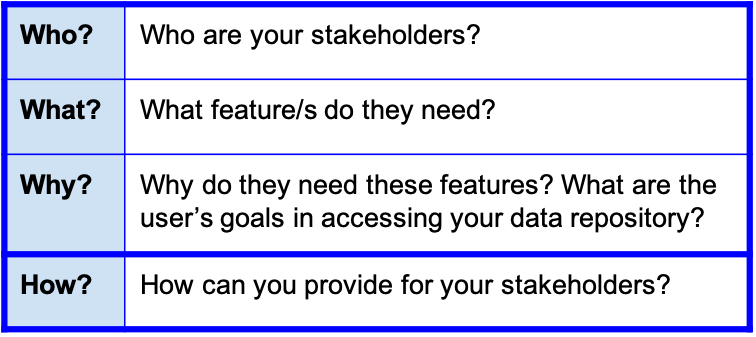Users and Uses Assignment
Assignment: User Stories & Use Cases
Throughout this class we will read examples of data curation work that is “user centered.” Two broad techniques for developing requirements of systems that are “human centered” are through use cases, and user stories.
User stories are a simple but powerful way to capture requirements when doing systems analysis and development. The level of detail, and the specific narrative style will vary greatly depending on the intended audience. For example, if we want to create a user story for accessing data stored in our repository we will need to think closely about different types of users, their skills, the ways they could access data, the different data they may want, etc. However, we don’t want this user story to turn into something so complicated that it is overwhelming to translate into actionable policy or features of our data repository. So we we can try to atomize a user experience and come up with a simple story that tells us the “who what and why” - so that we can figure out “how.”

There is also a template example below to help you think through creating a user story. Another way to begin gathering information about users and their expectations for data are through use cases. In week 2, one of the required readings was an example use case that W3C developed. Use their template to investigate best practices for data and repositories that are relevant to your protocol project.
Creating User Stories
Elements
The three most basic elements of a user story are:
- Stakeholder: the type of stakeholder might be a user, curators, administrator, etc.
- Feature: this could be a feature of a dataset, a system, or service
- Goal: what is the stakeholder trying to achieve with the feature?
Templates
A template for a user story goes something like this:
As a user I want some feature so that I can achieve some goal.
As a data user of the QDR I want to find all datasets about recycling for cities in Pacific Northwest so that I can reliably compare recycling program policies and outcomes for this region.
Variation on a theme: More recent work in human centered design places the goals first - that is, it attempts to say what is trying to be done, before even saying who is trying to do it.
This is helpful for thinking about goals that may be shared across different user or stakeholder types.
This variation of a user story goes something like:
In order to achieve some business value as a stakeholder type I want some new system feature.
Your Task
Create user stories that help you understand the potential wants, needs, and desires of your designated community of users. For this first attempt - focus on user stories around data sharing. How might you satisfy these user stories? What choices do these stories help clarify or obscure about your protocol, and your designated community?
Here is an example that can help clarify the way that user stories are assembled for the protocol.
Protocol Deliverable
For this assignment you will submit to Canvas a document that addresses the following:
- Describe potential users. Who is the audience for your data repository/collection?
- Choose an existing openly available dataset within your topic domain and provide an overview.
- Choose one potential user (or user group such as “policymaker”). Write their story. What is their use case? What do they want from the collection? What is their goal in accessing the data?
- Assess the dataset’s ability to meet the users goals. Does this dataset provide them everything they need? How will they access the data? What will they do with the data? What features are missing for your user?
For your final deliverable you will be doing this for each of your users, but in a more truncated fashion. You won’t need to include overviews and assessments of each dataset for each user.
Late Policy
- All assignments are due at 11:59 PM Pacific Time unless otherwise noted.
- If you cannot meet a deadline please get in touch with me 24 hours in advance of the due date to request an extension. - I have a "no questions asked" policy on extensions. I will not ask you to share the personal reasons why you need an extension, but if you would like to share with me for any reason please feel free. I am available listen.
- If you have not made arrangments with me, all late work will be automatically penalized 10% of the final grade of the assignment (e.g. If you would have received a 100% you will receive a 90%.) and will incur a 10% penalty for each additional day that the assignment is not complete.
- For those of you working in groups, please remember that your group members will be negatively impacted by any unexcused lateness on your part.
